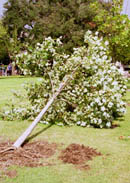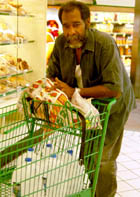With threats of hurricanes gone for the near future, Loyola is dealing with the aftermath and four and a half days of lost classes.
Tropical Storm Isidore posed a threat to the New Orleans area, and in response to the dangers, the university closed school Sept. 24 at noon. School re-opened Sept. 30.
The Emergency Preparedness Committee is responsible for the decisions of the university in such situations. The committee is headed by Vice President of Student Affairs Jim Eiseman and has members from departments such as Residential Life and Physical Plant.
According to Eiseman, the decisions made by the committee are the official stance of the university.
“The committee meets to discuss the various options that we have in the event of hurricanes,” he said. “We have plans from dealing with a tropical storm to a Category 5 hurricane.”
Loyola’s hurricane emergency plan is posted on the main Web site. The plan was changed over the summer, and the changes were made known to the student body in a campus e-mail Sept. 19.
Isidore was projected to strike New Orleans as a major hurricane. This projected path had affected the decision making process of the university.
“Before Isidore stalled over the Yucatan Peninsula, New Orleans was facing a severe hurricane,” Eiseman said.”We wanted to make sure that everyone had time to evacuate and reach safety.”
Isidore eventually struck the New Orleans area as a tropical storm and met a very empty campus.
“Campus was like a ghost town,” Brandon Thibodeaux, international economics junior, said. “The majority of the freshmen fled because they had never dealt with hurricanes.”
Residential Life was already telling students to make evacuation plans the Friday before Isidore, according to Robert Reed, director of Residential Life.
Reed also said that Residential Life never told anyone to evacuate until after classes were cancelled.
“I have heard some rumors that we were telling people to leave as early as Sunday,” he said, “but those were personal decisions that people made for their own safety.”
Hurricane Lili saw the university cancel just one day of classes, Oct. 3. Although Lili was a more severe storm, Loyola waited until the day before landfall to cancel any classes. According to Eiseman, the missed days of Isidore had no effect on the decision making process.
“No, we can’t do that (make decisions based on prior instances), we looked at this storm as something completely different from Isidore,” he said. “We were looking out for the safety of the students.”
Some students say that the university may have been a little gun-shy about canceling classes for Lili.
“I understand that decisions can’t always be made right away, but the university really seemed to wait too long because of what happened during Isidore,” said Lauren Campo, communications studies junior and commuter student.
The university did lose power for at least an hour during Lili. However, the back up generators provided emergency lighting in the residence halls.
“We were pretty lucky for both hurricanes,” Reed said. “It could have been a lot worse for both, but there was still some damage.”
The university’s official plan for hurricanes has five clear stages.
The first stage is a hurricane watch, which sets the wheels in motion. All departments are notified of the dangers and the residence halls do not allow any alcoholic beverages into the building.
Second, a hurricane warning is issued, which means that Cabra residents are moved to the Rec Plex and supplies are moved into the residence halls.
The third stage comes six hours prior to the onset of the hurricane. Students are required to stay in the dorms and may not leave unless signing a release form. Once a student leaves, he or she cannot reenter the dorms until after the storm.
Stage four is the onset of the hurricane in which all students are required to stay indoors and may be asked to move to the hallways. Stage five is the aftermath of the storm when Physical Plant will survey the damage and decide when it is safe to leave the dorms.
In the event of a Category 2 or above the university has plans to evacuate the remaining students.
“If a major storm was to hit, we would need about three days to put everyone into vans and drive them to our shelters,” Eiseman said. “For Isidore, our shelter was in Mississippi.”
Damage on Campus
The wind and rain of the storms damaged trees and buildings across campus.
Some trees were blown over, and there were leaks in the residence halls.
The New Residence Hall experienced most of the water damage.Several students came back after evacuating to find their rooms in a puddle of water.
Paige Patriarca, international business sophomore, lives on third floor of the New Hall. During Isidore, water leaked through the walls and into her room.
“When I came back on Sunday, the smell was so God awful and the carpet was soaking wet,” she said. “It was hard to even open the door.”
Physical Plant director Paul Fleming did not return phone calls, but the department did provide some information. The damage to campus by both storms was minimal.
According to Patriarca, the same thing happened for Lili.
“We came back from Lili, and there are actually puddles of water on top of the carpet,” she said.
The leaks were one of the worst problems in the residence halls, according to Reed.
“We have had some leaks from places that we didn’t even know could do that,” he said. “It was difficult to fix all of the problems between hurricanes because there was simply not enough time between the two storms.”
There were also leaks in Buddig and Biever Halls. However, according to Matt Jackson, international business/marketing junior and resident assistant in Buddig, the damage was very minor.
“There were a few leaks in some of my residents’ rooms, but Physical Plant took care of them quickly,” he said.
Residents of Cabra Hall were also forced to evacuate to the Rec Plex for hurricane Lili because of the possibility of flooding.
Residents were not the only ones facing problems. Commuters were faced with the problem of actually knowing if school was still in session or not.
“I think that they could have made some decisions more quickly,” Campo said. “It was really frustrating not knowing if I had class that day or not.”
The Emergency Preparedness Committee will have a meeting to discuss the actions of the past two weeks and discuss any improvements to the program.

A tree lies fallen in the Peace Quad after tropical storm calibur winds from Lili swept through New Orleans. Aside from tree debris and puddles, campus was left relatively unharmed. (Sarah Fleming)

The Sav-A-Center on Tchoupitoulas Street had empty shelves as residents stocked up on water and supplies in order to wait out another storm as Lili approached the New Orleans area last week. Bottled water, batteries and canned goods were sold out quickly as locals prepared for what was expected to be a Category 4 hurricane. (Katie Kennedy)






